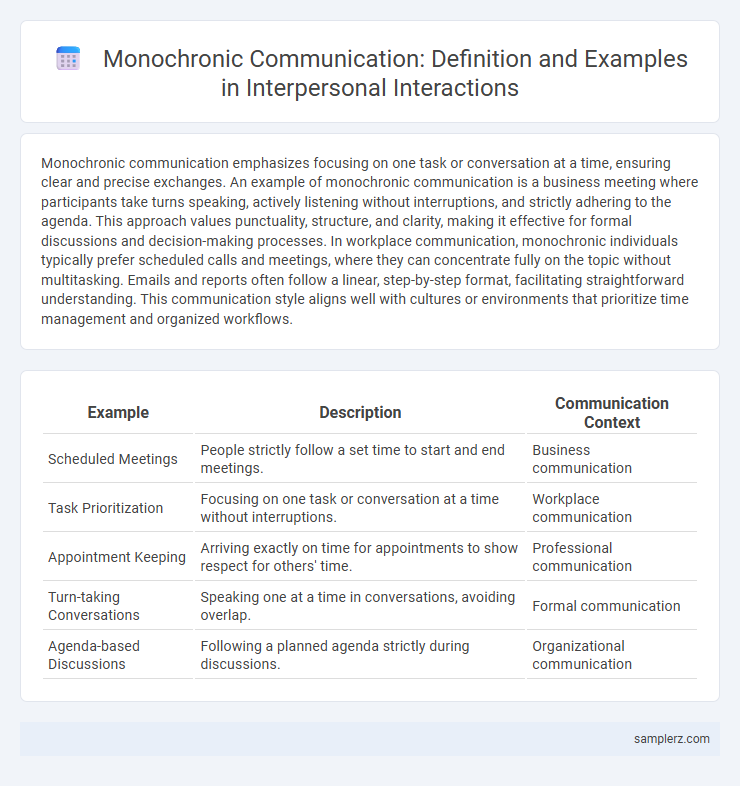Monochronic communication emphasizes focusing on one task or conversation at a time, ensuring clear and precise exchanges. An example of monochronic communication is a business meeting where participants take turns speaking, actively listening without interruptions, and strictly adhering to the agenda. This approach values punctuality, structure, and clarity, making it effective for formal discussions and decision-making processes. In workplace communication, monochronic individuals typically prefer scheduled calls and meetings, where they can concentrate fully on the topic without multitasking. Emails and reports often follow a linear, step-by-step format, facilitating straightforward understanding. This communication style aligns well with cultures or environments that prioritize time management and organized workflows.
Table of Comparison
| Example | Description | Communication Context |
|---|---|---|
| Scheduled Meetings | People strictly follow a set time to start and end meetings. | Business communication |
| Task Prioritization | Focusing on one task or conversation at a time without interruptions. | Workplace communication |
| Appointment Keeping | Arriving exactly on time for appointments to show respect for others' time. | Professional communication |
| Turn-taking Conversations | Speaking one at a time in conversations, avoiding overlap. | Formal communication |
| Agenda-based Discussions | Following a planned agenda strictly during discussions. | Organizational communication |
Understanding Monochronic Communication
Monochronic communication emphasizes punctuality, structured schedules, and a focus on one task at a time, often seen in Western cultures like the United States and Germany. This communication style values clear agendas and strict adherence to deadlines, which enhances efficiency and reduces misunderstandings. Understanding monochronic communication helps improve collaboration by aligning expectations around time management and task prioritization.
Key Traits of Monochronic Communicators
Monochronic communicators prioritize punctuality, structure, and task completion, valuing schedules and timeliness in interactions. They focus on one conversation or task at a time, avoiding multitasking to maintain clarity and efficiency. Clear deadlines and organized agendas are essential in their communication style, reflecting a preference for order and predictability.
Time Management in Monochronic Cultures
In monochronic cultures, time management is characterized by strict adherence to schedules and punctuality, emphasizing the importance of completing one task at a time. Meetings and deadlines are highly structured, reflecting a linear approach to time where interruptions are minimized to maintain efficiency. This focus on sequential task execution supports clear communication and reduces ambiguity in professional and social interactions.
Monochronic Behaviors in the Workplace
Monochronic behaviors in the workplace emphasize punctuality, scheduled meetings, and strict adherence to deadlines, reflecting a linear approach to time management. Employees from monochronic cultures typically prioritize completing one task at a time to maximize efficiency and minimize distractions. This communication style supports structured collaboration and clear expectations in professional environments.
Examples of Monochronic Communication in Meetings
Monochronic communication in meetings emphasizes strict adherence to schedules, detailed agendas, and timely completion of topics. Participants often follow a linear progression, addressing one issue at a time without interruptions to maintain focus and efficiency. This approach is common in corporate environments where punctuality and order are prioritized to optimize productivity.
Scheduling and Punctuality in Monochronic Contexts
Monochronic communication emphasizes strict adherence to schedules, where punctuality is a critical component in professional and social interactions. In monochronic cultures, meetings and deadlines are scheduled with precise start and end times, reflecting a linear approach to time management. This focus on timeliness ensures efficient task completion and conveys respect for others' time.
Monochronic Communication in Customer Service
Monochronic communication in customer service emphasizes punctuality, clear scheduling, and task-oriented interactions to meet client expectations efficiently. Representatives follow structured procedures and adhere strictly to appointment times, ensuring timely resolution and minimal disruptions. This approach enhances reliability and builds customer trust through consistent, focused communication channels.
Impact on Interpersonal Relationships
Monochronic communication, characterized by strict adherence to schedules and punctuality, often enhances trust and reliability in interpersonal relationships by demonstrating respect for others' time. This time-focused approach can lead to efficient and clear exchanges but may also cause stress or misunderstandings when partners value flexibility and spontaneity. Understanding the monochronic style's emphasis on order helps improve collaboration and reduces conflicts in multicultural communication settings.
Challenges in Cross-Cultural Communication
Monochronic communication, characterized by a strict adherence to schedules and punctuality, often creates challenges in cross-cultural settings where polychronic cultures value flexibility and relationship-building over time constraints. This difference can lead to misunderstandings, as monochronic communicators may perceive polychronic counterparts as disorganized or disrespectful, while the latter may view strict time adherence as rigid or impersonal. Effective cross-cultural communication requires awareness of these temporal preferences to navigate potential conflicts and foster mutual respect in diverse interactions.
Best Practices for Monochronic Interactions
Scheduling meetings with precise start and end times exemplifies best practices for monochronic communication, emphasizing punctuality and task-oriented interactions. Using detailed agendas and time blocks ensures efficient use of time and minimizes distractions during discussions. Respecting individual time commitments fosters trust and promotes clarity in professional and personal monochronic interactions.

example of monochronic in communication Infographic
 samplerz.com
samplerz.com